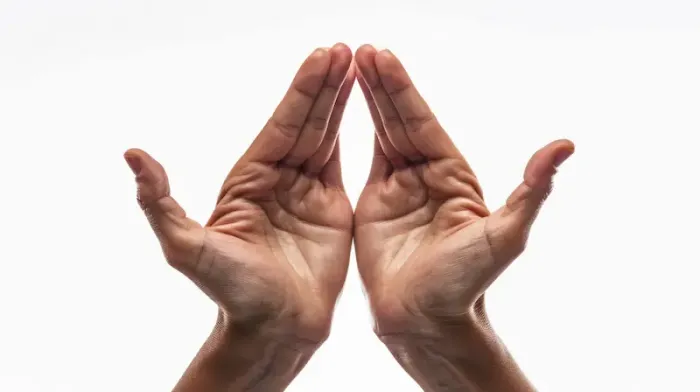Shambhavi Mudra Steps, Benefits, and Meditation Guide
Learn Shambhavi Mudra steps, Shambhavi Mudra benefits, and a simple meditation guide. Get safety tips and science-backed ways to reduce stress.

Written by Dr. Siri Nallapu
Reviewed by Dr. Dhankecha Mayank Dineshbhai MBBS
Last updated on 17th Nov, 2025

Introduction
If you’re curious about simple, practical ways to feel calmer and more focused, Shambhavi Mudra is worth exploring. It’s a traditional yogic gaze technique often used within meditation to steady attention and relax the nervous system. While specific research on Shambhavi is limited, a large body of evidence shows that regular meditation can reduce stress, support emotional well-being, and improve focus. In this guide, you’ll learn what Shambhavi Mudra is, how to practice it safely, what the potential Shambhavi Mudra benefits are, and how to build a short daily routine you can stick with.
What is Shambhavi Mudra?
Shambhavi Mudra is a classical yoga technique in which you gently direct your gaze toward the space between your eyebrows (often called the “brow center”) while keeping the face soft and the breath steady. Practitioners use it to anchor attention, calm mental chatter, and support a meditative state.
Important Context:
• Evidence specific to Shambhavi Mudra is limited. Most health-related benefits come from broader research on meditation, mindfulness, and breathing practices.
• This technique should feel effortless. Avoid eye strain or force.
How to Practice Shambhavi Mudra (Step-by-Step)
Here’s a step-by-step guide to practise shambhavi mudra:
Set Up
1. Choose a comfortable seat: Sit on a chair or cushion with your spine upright and shoulders relaxed.
2. Hand position: Rest your hands on your thighs or in your lap; palms can be up or down.
3. Soften the face: Unclench your jaw and release the tongue from the roof of your mouth.
Gaze and Breath
4. Gentle gaze: With eyes softly open or half-closed, let your gaze drift toward the point between your eyebrows. Do not force your eyes upward; aim for a light, relaxed upward gaze.
5. Easy breath: Breathe naturally through the nose. Keep the breath quiet and even.
6. Attention: Notice the feeling of the breath and the soft sensation at the brow center. If the eyes get tired, briefly close them, then resume gently.
Timing and Progression
7. Start small: Begin with 2–3 minutes. Over 2–4 weeks, gradually work up to 8–10 minutes if comfortable.
8. Finish slowly: Release the gaze, blink a few times, and take a couple of deeper breaths before opening your eyes fully and returning to your day.
Tips for Comfort and Success
• No strain: If you feel eye strain, headaches, or dizziness, close your eyes and simply rest attention at the brow center without directing the gaze.
• Posture check: If your lower back tyres, sit with your back supported.
• Gentle focus: Let thoughts come and go without judgment. Keep returning to the breath and the soft brow focus.
Common Mistakes to Avoid
Here are some mistakes you should avoid:
• Forcing the eyes upward or holding the breath
• Tightening the forehead or jaw
• Practising for too long at first
• Expecting instant results; meditation benefits accumulate with regular practice
How Long and How Often Should You Practice?
• Beginners: 3–5 minutes, once daily
• Intermediate: 8–10 minutes, once or twice daily
• On busy days: Even 2 minutes can help you reset
Shambhavi Mudra Benefits: What You May Notice
From a practical standpoint, people often report:
• A calmer, more focused mind during and after practice
• Less reactivity to stressors
• Improved body awareness and posture
What the Science Supports: Meditation More Broadly
While specific trials on Shambhavi Mudra are limited, research on meditation and related mind-body practices shows:
• Stress reduction: Meditation can help lower perceived stress and support relaxation.
• Mood and anxiety support: Mindfulness and meditation-based programs may reduce symptoms of anxiety and mild to moderate depression for some people.
• Focus and sleep: Regular meditation is linked with improved attention and, for some, better sleep quality.
• Blood pressure and heart health: Some practices can lead to modest improvements in blood pressure and stress-related biomarkers when combined with healthy lifestyle habits.
These outcomes vary by individual, consistency, and the specific technique used. Use Shambhavi Mudra as one approachable way to build a meditation routine that may deliver these evidence-supported benefits over time.
Safety and Precautions
Shambhavi Mudra is generally gentle, but keep these points in mind:
• Eye concerns: If you have glaucoma, significant eye strain, recent eye surgery, or frequent headaches triggered by eye movements, avoid the upward gaze. Instead, practice with eyes closed and relaxed attention at the brow center. Consult your eye-care professional if unsure.
• Neurological conditions: If you have a seizure disorder or a history of concussions with visual triggers, speak with your clinician before trying gaze-based practices.
• Mental health: Meditation is a helpful wellness tool but not a substitute for professional care. If you have a mental health condition, practice under guidance from a qualified instructor and keep your healthcare provider informed.
• Dizziness or discomfort: Stop if you feel unwell. Resume later with shorter sessions or eyes closed.
Consult Top Specialists
How Shambhavi Mudra Fits into Meditation and Yoga?
You can use Shambhavi Mudra as:
• A stand-alone 5–10 minute meditation
• The focusing element within a longer mindfulness session
• A transition between yoga postures and seated meditation
• A quick mid-day reset to reduce screen fatigue and mental clutter
A Simple 10-Minute Shambhavi Mudra Meditation
Try this once daily for two weeks:
• Minute 0–1: Sit comfortably. Relax your shoulders and jaw. Take two slow, natural breaths.
• Minute 1–3: Soften your eyes. Gently direct your gaze toward the area between the eyebrows without strain. Let the breath be easy.
• Minute 3–6: Each time you notice thoughts, label them “thinking” and return to the breath and soft brow focus.
• Minute 6–9: Set a light intention (for example, “calm and clarity”). Continue gentle breathing and relaxed gaze.
• Minute 9–10: Close the eyes, release the gaze, take two deeper breaths, and open the eyes slowly.
How to Build Consistency?
• Pair with a habit: Practice right after brushing your teeth or after a walk.
• Set a cue: Use a soft chime or phone reminder (in airplane mode during practice).
• Track it: Mark a calendar or use a simple notebook to log minutes.
• Keep it kind: If you miss a day, resume the next without self-criticism.
Who Might Benefit Most?
While anyone can try Shambhavi Mudra, people who often benefit from building a daily meditation habit include:
• Those experiencing everyday stress who want a quick, portable technique
• Professionals who need a short focus reset between tasks
• Students seeking steadier attention for studying
• People looking for a gentle, seated practice to complement yoga or walking
How Shambhavi Mudra Compares with Other Meditation Techniques?
Let’s see how shambhavi mudra compares with other meditation techniques:
• Breath awareness: Focus stays at the sensations of breathing; eyes usually closed. Shambhavi adds a gentle brow-center gaze as an anchor.
• Body scan: Moves attention through body regions; Shambhavi keeps attention relatively fixed at one point.
• Loving-kindness (Metta): Focuses on cultivating goodwill; Shambhavi is more attention-stabilising.
• Mindfulness of thoughts: Observes thoughts as they arise; Shambhavi does this too but emphasises a steady visual focal point.
When Will You Notice Results?
Some people feel calmer after a single session. Most meaningful changes—like improved stress tolerance or focus—come from regular practice over weeks. Start with a realistic goal: 5 minutes a day for 14 days, and adjust as you learn what works best for your body and schedule.
Consult Top Specialists
Consult Top Specialists

Dr. Chethan T L
General Physician/ Internal Medicine Specialist
5 Years • MBBS, MD, DNB (General Medicine)
Bengaluru
Apollo Medical Center, Marathahalli, Bengaluru

Dr. Rajib Ghose
General Physician/ Internal Medicine Specialist
25 Years • MBBS
East Midnapore
VIVEKANANDA SEBA SADAN, East Midnapore

Dr Divya Lekha Gunta
General Practitioner
10 Years • MBBS, MD (Pathology)
Visakhapatnam
Apollo 24|7 Clinic - Andhra Pradesh, Visakhapatnam

Dr. Anand Misra
General Physician/ Internal Medicine Specialist
14 Years • MBBS, DNB
Mumbai
Apollo Hospitals CBD Belapur, Mumbai

Dr. R Gopakumar
Internal Medicine/ Covid Consultation Specialist
31 Years • MBBS, MD(general medicine
Angamaly
Apollo Hospitals Karukutty, Angamaly
(25+ Patients)
Consult Top Specialists

Dr. Chethan T L
General Physician/ Internal Medicine Specialist
5 Years • MBBS, MD, DNB (General Medicine)
Bengaluru
Apollo Medical Center, Marathahalli, Bengaluru

Dr. Rajib Ghose
General Physician/ Internal Medicine Specialist
25 Years • MBBS
East Midnapore
VIVEKANANDA SEBA SADAN, East Midnapore

Dr Divya Lekha Gunta
General Practitioner
10 Years • MBBS, MD (Pathology)
Visakhapatnam
Apollo 24|7 Clinic - Andhra Pradesh, Visakhapatnam

Dr. Anand Misra
General Physician/ Internal Medicine Specialist
14 Years • MBBS, DNB
Mumbai
Apollo Hospitals CBD Belapur, Mumbai

Dr. R Gopakumar
Internal Medicine/ Covid Consultation Specialist
31 Years • MBBS, MD(general medicine
Angamaly
Apollo Hospitals Karukutty, Angamaly
(25+ Patients)
More articles from General Medical Consultation
Frequently Asked Questions
1) What are the main shambhavi mudra benefits?
You may notice improved focus, a calmer mind, and less reactivity to stress. These align with research on meditation more broadly. Specific clinical evidence on Shambhavi Mudra itself is limited, so treat it as one effective way to practice meditation regularly.
2) Is Shambhavi Mudra safe for beginners?
Yes—when done gently and without forcing the eyes. If you experience eye strain or headaches, close your eyes and simply rest attention at the brow center. Start with short sessions and build gradually.
3) How is Shambhavi Mudra different from regular meditation?
It uses a soft, upward gaze toward the space between the eyebrows as the main point of focus. Many other meditation styles keep the eyes closed or use the breath alone as the anchor.
4) Can Shambhavi Mudra help with anxiety or sleep?
Meditation in general may help reduce anxiety symptoms and improve sleep quality for some people. Results vary, and it’s not a replacement for professional care. Consider combining Shambhavi Mudra with other healthy habits and guidance from your clinician if needed.
5) How often should I practice to see benefits?
Consistency matters more than length. Aim for 5–10 minutes daily. Over several weeks, many people report greater calm and focus, similar to benefits seen in regular meditation practice.




